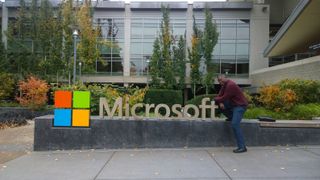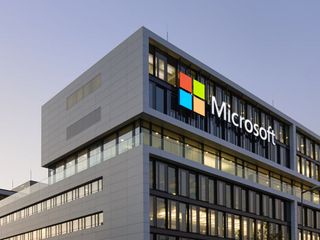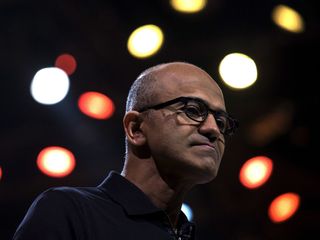Is Microsoft passionate about its mobile strategy?
Is Microsoft passionate about its mobile strategy?

That's the burning question that has dripped from the tips of razor sharp tongues of many Windows phone fans. Cutting deep into the ether of social media and comment sections of articles written about Microsoft's mobile strategy this question has been followed by an even hotter and sharper response. To encapsulate the verbose rants into the what seems to be the consensus, "No" resounds as the reverberating retort.
This assessment is founded on the belief that Microsoft's investments in other platforms, their retreat from the consumer smartphone space, a history of limited marketing efforts, an apparent silence regarding its mobile plans and more are a testimony of this alleged non-commital attitude.
The look of commitment

To be sure, Microsoft's mobile efforts have been in a perpetual state of flux for years. As they have sought a foothold in the consumer space, Nadella has laid out a grand plan that targets a paradigm shift in what lies beyond the smartphone in the future. The current smartphone paradigm and app model have been lost, and a future of AI, bots and context aware hardware and software are the foundations and context of this new paradigm. So, is Microsoft passionate about mobile? In agreement with the collection of voices of detractors, angry fans and critics, in the traditional sense, no. But that's not the whole story.
Microsoft is looking beyond the smartphone.
Microsoft's mobile strategy looks beyond the linear rectangular slab of high-end hardware and an app catalog strategy. Redmond is looking toward an interdisciplinary approach that necessitates a synergy of, as yet, undefined context sensitive hardware, flexible software and an ecosystem of AI and bots where conversation as a canvas plays a significant role. This new vision of mobile is what Microsoft is passionate about.
Such a vision and foundation requires the strong collaboration of diverse teams at Microsoft which speaks to the various reorgs we have seen recently. The question now is, are the teams passionate about the synergistic end of the collaborative effects of their work or is Microsoft still suffering from the siloed effects of a patchwork of departments operating as individual units?
What is Continuum?
During a recent trip to Microsoft's headquarters in Redmond, Washington, I had an interesting experience. To a very nice and helpful engineer, I posed the question "Will Sway be able to use Continuum like the other Office apps? In a response, which is by no means reflective of his competence (he is very knowledgeable, and I believe very intelligent) he responded, "What is Continuum?"
It seemed there were others (engineers and a visitor like myself) present that were as uncertain as he was as I explained the function. I would have thought that all Microsoft employees would have known the term Continuum and what it means in relation to Windows Mobile. I was wrong.
Get the Windows Central Newsletter
All the latest news, reviews, and guides for Windows and Xbox diehards.
To be fair, once I began describing Continuum to the Microsoft employee, something registered in him. He shared that he knew of the function but didn't know the term Continuum. That's fine.
I thought all Microsoft employees knew the term Continuum. I was wrong.
And, of course, this anecdotal experience doesn't speak for the state of all of Microsoft. But if this engineer's lack of awareness of a key differentiator for Microsoft's mobile platform is indicative of other members of other teams, there is a legitimate concern that the "siloed" Microsoft legacy persists. The affects of this potential communication barrier are exacerbated by a lack of personal Windows phone usage among Microsoft employees. But we'll get to that soon enough.
Siloed

It is no secret that Microsoft has a history of operating as a collage of diverse companies rather than one unified firm with many divisions. The "One Microsoft" initiative which began under former CEO Steve Ballmer was initiated to eradicate that practice. Earlier this year I interviewed Microsoft employees Chris Pratley, Mike Tholfsen and Chris Yu about this very subject. The resounding theme from each of these men was that Microsoft had improved significantly in that area and the company was now operating as more of a unified whole rather than as disparate units as in years past. I am sure that this is true.
My limited and admittedly anecdotal experience with a Microsoft engineer that did not readily know what Continuum was raises some concerns, however, that there still may be some cross-department communication barriers that need to come down. This assessment was further affirmed by a Microsoft employee I met at the airport as I was leaving Washington. After I mentioned the "One Microsoft" initiative during our small talk, he conveyed, that Microsoft is a big ship and that change takes time. In other words, all of the walls are not yet down. This is an honest acknowledgment that speaks to the struggles Redmond is facing.
The teams must be as unified as the vision put forth for the platform.
Microsoft must be recognized, however. In an unprecedented accomplishment, the company achieved what no other tech company has achieved with the formation of a unified OS. One Windows was a dream decades in the making. There is no greater time than now, during the early stages of Microsoft's flagship product as a pioneering unified ecosystem, for the company to reflect that same unity.
In truth, such unity is more than a symbolic reflection. With Windows as a service, coupled with cloud-based computing, AI, gaming, productivity tools such as Office and Redmond's hardware investments in HoloLens, Surface and more Windows is, in fact, a singular portal to a diversity of Microsoft's products and services. As the foundation for this unity, the teams that support the products must be as unified as the vision put forth for the platform.
What's in your pocket

Microsoft's interdisciplinary approach to a category-defining mobile strategy faces a unique challenge that its rivals with a traditional linear approach don't even face. 99% of the consumer smartphone space is dominated by iPhones and Android phones. This is also true of the 100,000 Microsoft employees — most of those I encountered used iPhones or Android phones.
The company one works for does not dictate his mobile platform preference.
Of course, even in the enterprise, employees are consumers first. So, whatever platform suits them outside of the office is what they will carry into the office. This reality is true even for a Microsoft employee. That's fine. Contrary to the wishes of many fans, a commitment to the company which employs an individual does not dictate one's mobile platform preference.
The effects of this reality on the passion of people that are working on components of Microsoft's grand mobile vision is something to consider, however. Consider this: A visit to Apple's Cupertino campus would likely reveal a vast number of employees that work on the various aspects that make the iPhone experience what it is, are also consumers who use the iPhone personally in their everyday lives.
There is value drawn from insights born of personal investment in a platform.
The same is likely true for Google employees. A visit to Mountain View would likely reveal employees that build into the Android experience are also consumers who passionately and personally enjoy an array of Android phones. This can only be good for a consumer's mobile experience on those respective platforms.
Of course, there are Microsoft employees that use Windows phones. And naturally, new features and services are tested on Windows phones by employees for whom a Window phone may not be their personal device. There is something to be said, however, about the passion and insights one draws when there is a personal and experiential investment in a platform.
Mobile matters

Mobile computing on smartphones is where most personal computing is taking place daily. Any company that wants to be relevant in personal computing must, therefore, position its mobile platform as a priority. Of course, we understand that Microsoft's Universal Windows Platform is touted as a single platform for all device types and screen sizes. In a broad, slow moving and indirect way the progress of Windows 10 is positioning Microsoft's mobile play.
Hypothetically if all ecosystem variables were in place, Windows 10 Mobile would be heavily marketed with Windows 10 on PC even now. Sadly, the app gap positions Microsoft to be heavily dependent on future technologies like bots and AI and other innovations before it can make another real attempt at the consumer space.
Microsoft employees, like everyone else, are smartphone consumers.
Withdrawal of first-party hardware and now the mobile platform altogether from the consumer space is a blatant concession. Redmond has effectively stated that its mobile platform that powers current first-party phones and manufacturing partner devices, for the coming years is strictly enterprise- and not consumer-focused. Of course, Microsoft employees who are building the Windows Mobile experience, as smartphone consumers, are inevitably affected by this strategy.
Communication issues
For Microsoft to ensure ecosystem synergy, intense and deliberate communication and collaboration across divisions is both expected and required. The fact that a Sway engineer did not know the term Continuum begs the question, "Is this communication happening?" I got the feeling that an engineer's time is spent absorbed in programming virtually all day every day. If other department's staff are as hyper-focused on just their "slice of the pie," I can certainly understand why knowledge of other divisions may rarely break through.

Sadly, given the state of Windows phone, it seems that most Microsoft employees, like other smartphone consumers, have limited experience, knowledge and passion for Windows Mobile. Like most mobile phone users, you know and love what you use.
Microsoft employees, as consumers, aren't passionate about Windows phones.
Several Microsoft employees admitted to me that they switched from Windows phone to competing platforms. The employee I met at the airport, who shared that there is still a division between the divisions shared that he switched as well. He made the change after he felt Microsoft was no longer investing in the platform. Of course, he does not speak for the company (I believe that Microsoft is indeed making long-term investments in mobile), but from a consumer perspective, it speaks volumes.
It is often difficult to see a situation the way an outsider perceives it when you are knee deep in it daily. Satya Nadella might assume that his vision for mobile and Continuum has been adequately communicated throughout the various divisions that will make Redmond's One Windows vision a success. He may feel that he would be "preaching to the choir" if he were to consistently reiterate the vision to ensure that every employee in every division understood how their contributions would forge the mobile vision.
Well, Mr. Nadella, when a Microsoft employee asks, "What is Continuum?", that vision might not be as fully communicated as you'd like. That employee and potentially others who have no personal passion for the platform may not see your vision:
What is unique about our phones is this Continuum feature.Just like how with Surface we were able to create a category. Three years ago most people would have said, "What is a two-in-one?" And now even Apple has a 2-in-1. And so three years from now, I hope that people will look and say, Oh wow, that's right, this is a phone that can also be a PC.
As the walls continue to fall between departments, "preach" Mr. Nadella, the choir needs to hear you.
Where the passion lies

With the introduction of the Surface, Surface Book, the incredible Surface Studio and Surface dial and 3D capabilities built into Windows, Microsoft has proven that it is an innovative company. Microsoft fans are not the only ones making this claim.
Furthermore, as a leap into the future, HoloLens and Windows Holographic are positioning Microsoft to power an industry of Augmented and Virtual Reality headsets based on Windows 10. All of these innovations from the Surface line to AR and VR hardware required the passionate collaboration of multiple Microsoft teams to make Windows 10 shine across that family of hardware and form factors.
Partners are also passionate. HP, Dell, Acer Asus and Lenovo have all partnered with Microsoft to bring affordable VR headsets to market based on Windows Holographic. This and potential future partnerships as time moves on will help push Windows Holographic throughout the industry.
Naturally, as time goes on and the tech iterates the cost for building wearable computing devices will drop. This progress will make devices more affordable to consumers over time potentially resulting in the mainstreaming of wearable devices. As we know, HoloLens is a purely standalone wearable computer. Conversely, many VR headsets are tethered (or potentially wirelessly) connected to a PC.

Can Microsoft be aiming for AR glasses connected to a Continuum-powered 3-in-1?
Imagine what Microsoft may be looking toward five to ten years down the road. Can wearable AR "glasses," connected to a Continuum powered ultra-mobile PC, 3-in-1, be on the roadmap. According to some leaked data, Magic Leap is based on a similar concept.
Microsoft going down this path is, of course, speculation. If we believe that Microsoft is committed to mobile (as they say) and that they are looking beyond the bend in the curve, placing our attention on where they are investing may paint a picture of their goals.
Microsoft is passionate about Windows Holographic, context-sensitive hardware, the mobility of experiences and the convergence of various technologies. This passion may culminate in a synergy of technologies resulting in a category-defining device that benefits from its current investments. If this, or some other synergy of the technology Redmond is investing in are building blocks to their mobile play, then yes Microsoft is passionate about mobile. Of course, I may be completely wrong, but innovation is born of dreams.
What HoloLens and Windows Holographic mean for Microsoft and the future of personal computing
So what are your thoughts? Sound off in comments, forum and on Twitter!
Related reading:
- Windows phone isn't dead
- Smartphones are dead
- The untold app gap story
- AIs, Bots and Canvases
- Microsoft and the duo user
- The Surface Phone
- Windows Mobile and the enterprise
- Help my wife wants to switch from Windows phone to Android
Jason L Ward is a columnist at Windows Central. He provides unique big picture analysis of the complex world of Microsoft. Jason takes the small clues and gives you an insightful big picture perspective through storytelling that you won't find *anywhere* else. Seriously, this dude thinks outside the box. Follow him on Twitter at @JLTechWord. He's doing the "write" thing!

